When parenting goes cuckoo
Brood parasites trick another bird, fish or other animal into taking care of their young
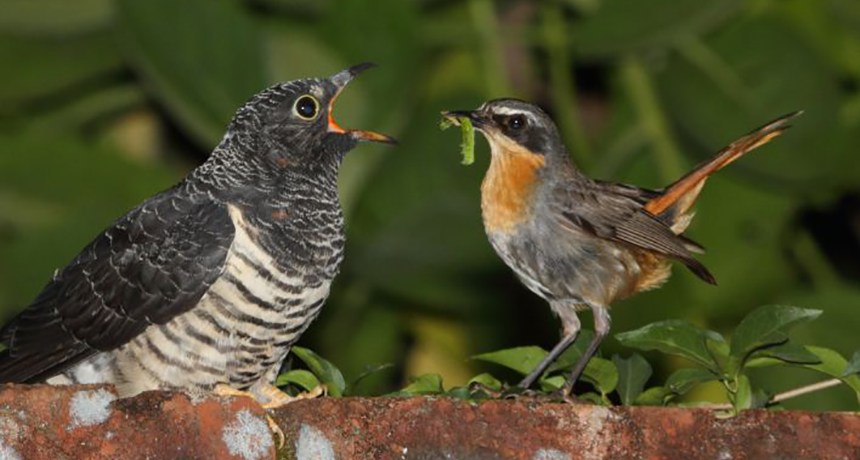
Brood parasites leave their young with another animal who acts as a “foster parent.” Here, the foster parent is a cape robin-chat (right). It is feeding an enormous chick of another species, a red-chested cuckoo (left).
Alandmanson/Wikimedia Commons (CC BY-SA 4.0)
By Roberta Kwok
In Europe, a bird called the common cuckoo uses a sneaky strategy to raise its babies. First, a female cuckoo finds a nest built by a bird of a different species. For example, it might be a great reed warbler. Then, she sneaks into the warblers’ nest, lays an egg and flies away. The warblers often accept the new egg. Indeed, they take care of it along with their own eggs.
Later, things turn nasty.
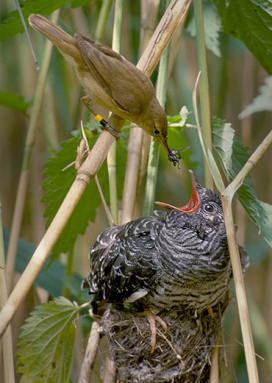
The cuckoo chick hatches before the warbler chicks. And it wants all the food from the warbler parents for itself. So the young cuckoo pushes the warbler eggs onto its back, one by one. It braces its feet on the sides of the nest and rolls each egg over the edge. Smash!
“It’s amazing,” notes Daniela Canestrari. She’s a biologist who studies animal behavior at the University of Oviedo in Spain. These chicks “kind of stand up until the egg just falls out.”
It’s not so amazing for the warblers. For some reason, the warbler parents keep feeding the cuckoo chick, even as their own offspring are gone. “This is very bad for the parents because they lose all of their chicks,” Canestrari says.
The common cuckoo is one example of a brood parasite. Such animals trick other animals into raising their young. They sneak their eggs into other parents’ nests.
Brood parasites are “basically looking for foster parents,” says Mark Hauber, a biologist. He studies animal behavior at the University of Illinois at Urbana-Champaign. The “foster parents” are also called “hosts.” Those hosts then feed and protect the parasite’s offspring.
Scientists find this behavior intriguing. And they have witnessed it in birds, fish and insects.
Some researchers are studying whether hosts recognize the alien eggs. Others are exploring how hosts evolve defenses against such parasites. And surprisingly, one team has learned that brood parasites aren’t all bad. Sometimes, they help actually aid their foster family.
Artur Homan
Here, raise my kids
Some animals don’t care for their young. They just leave their offspring to fend for themselves. Other animals take a more active role. They forage for food to feed their growing young. They also protect their young from predators and other dangers. Such duties up the chance their offspring will make it to adulthood.
But caring for young animals requires a lot of energy. Adults who gather food for babies might instead have spent that time feeding themselves. Defending their nest against predators could also get a parent injured or killed.
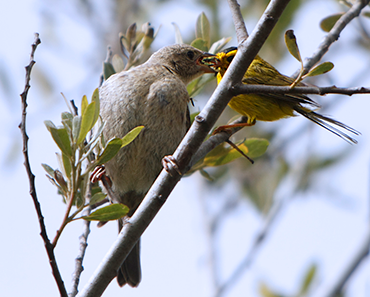
Brood parasites that trick someone else into doing the work can reap the benefits of raising offspring — without the costs. All animals want to pass on copies of their own genes to the next generation. The more young that survive, the better.
Not all brood parasites are as nasty as the common cuckoo. Some parasitic bird chicks grow up alongside their host nestmates. But these nest-crashers can still cause problems. For example, a parasitic chick might hog food. Then some chicks in the foster family could starve.
Some hosts fight back. They learn to recognize foreign eggs and toss them. And if hosts see a parasitic bird, they attack it. Among insects, hosts beat up and sting intruders.
But hosts sometimes just accept the brood parasite. Its egg may look so similar to their own that the hosts can’t tell them apart. After an egg hatches, hosts may suspect a chick isn’t theirs, but they don’t want to risk neglecting it. If they’re wrong, they would have killed one of their young. So they raise the young parasite alongside their own offspring.
Beige egg, blue egg
How closely must an egg resemble its hosts’ for those foster parents to accept it? Some researchers have studied this by using models of eggs made from materials such as clay, plaster or wood. Hauber tried a more advanced technique.
He made fake eggs with 3-D printing. This technology can create 3-D objects out of plastic. A machine melts the plastic, then deposits it in thin layers to build up the desired shape.
With this technique, the researchers created fake eggs with subtle shape differences. Then they watched to see how hosts responded to the different shapes.
Hauber’s team focused on brown-headed cowbirds. These brood parasites live in North America. They lay eggs in the nests of American robins.
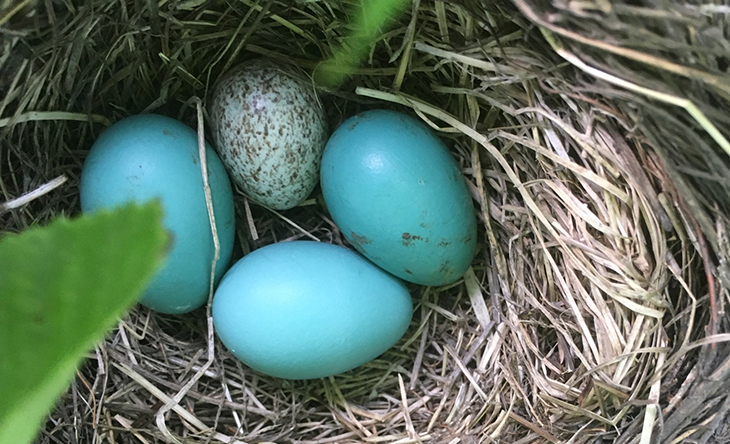
Robin eggs are bluish-green and don’t have spots. In contrast, cowbird eggs are beige and spotted. They also are quite a bit smaller than robin’s eggs. Often, the robin throws out the cowbird egg.
Hauber wondered how much the cowbird eggs would need to resemble a robin’s to be accepted. To find out, his team 3-D-printed 28 fake eggs. The researchers painted half of the eggs beige and the other half bluish-green.
All the faux eggs were roughly within the size range of real cowbird eggs. But some were slightly wider or longer than average. Others were a bit thinner or shorter than usual.
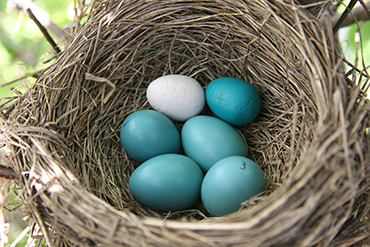
The team then visited robin nests in the wild. The researchers snuck fake eggs into the nests. Over the next week, they checked to see if the robins kept — or rejected — the fake eggs.
The results suggest that cowbirds would have more success in robin nests if they evolved to lay bluish-green eggs.
Robins threw out 79 percent of the beige eggs. But they kept all the bluish-green eggs, even though they were smaller than normal robin eggs. Minor shape differences among the fake bluish-green eggs didn’t seem to make a difference. “No matter the shape, they accept those eggs,” Hauber reports. So, he concludes, “The robin seems to pay less attention to size and more to color.”
Alien babies
Brood parasitism also happens in fish. But so far, scientists have found it in only one species: the cuckoo catfish. This fish lives in Lake Tanganyika (Tan-guh-NYEE-kuh) in eastern Africa.
Its hosts are fish species called mouthbrooding cichlids (SIK-lidz). During mating, a female cichlid lays her eggs on the lake floor. Then she quickly gathers the eggs in her mouth and carries them for a few weeks. After the eggs hatch, the little fish swim out of her mouth.
The cuckoo catfish messes up that process. When a female cichlid lays eggs, the female catfish rushes in and lays her eggs at the same spot or nearby. The cichlid and catfish eggs now get mixed up. The cichlid later scoops up her own eggs — and those of the catfish.
The baby catfish hatch inside the cichlid’s mouth and then go on to eat her own eggs. The hatchlings that eventually emerge from her mouth look very different from a cichlid.
“It would be like a human female giving birth to an alien,” says Martin Reichard. He is a biologist who studies how animals interact with their environment. Reichard works at the Czech Academy of Sciences in Brno, Czech Republic.
Reichard wondered if cichlids had evolved defenses against the cuckoo catfish. Some cichlid species have lived in Lake Tanganyika with the catfish for a long time. But mouthbrooding cichlids in other African lakes have never encountered cuckoo catfish.
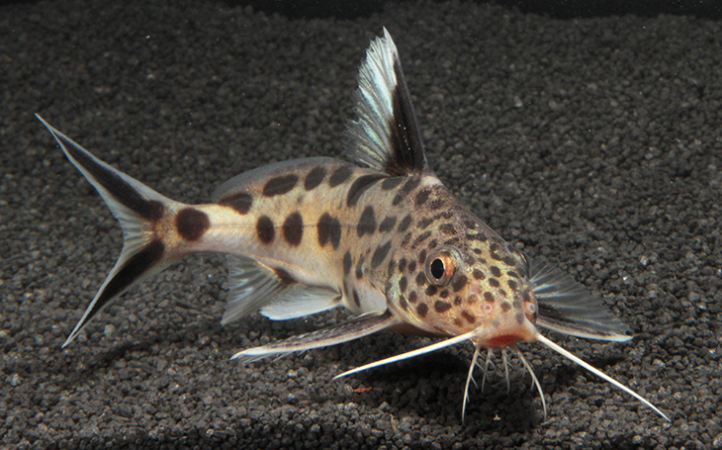
To investigate, his team observed cuckoo catfish and cichlids in the lab. One cichlid species was from Lake Tanganyika, and others came from different lakes. The researchers placed cuckoo catfish with various cichlid species in tanks.
Later, Reichard’s team caught the female cichlids. They squirted water into each fish’s mouth. This flushed out the eggs. Lake Tanganyika cichlids, they found, were much less likely than the other cichlids to carry catfish eggs.
The researchers wondered if Lake Tanganyika cichlids spit out the catfish eggs. To find out, they put female Lake Tanganyika cichlids in one tank. Female cichlids from another African lake, called Lake George, went in a separate tank.
Next, the scientists collected catfish eggs and fertilized them in a dish. They squirted six catfish eggs into each female cichlid’s mouth. Over the next day, the team counted how many catfish eggs ended up on each tank’s floor.
Only seven percent of the Lake George cichlids spit out catfish eggs. But 90 percent of the Lake Tanganyika cichlids had spit out catfish eggs.
It’s not clear how the Lake Tanganyika cichlids know to reject the intruders. Maybe the catfish eggs feel different in the cichlid’s mouth because of their shape and size. Or maybe they taste different.
That defense comes with a downside, however. Sometimes Lake Tanganyika cichlids spit out their own eggs along with catfish eggs. So the price of evicting the parasitic eggs was to sacrifice some of their own. Argues Reichard, that cost is “quite high.”
Smelly roommates
Brood parasites aren’t always bad news. Canestrari has found that some parasitic chicks that aid their foster family.
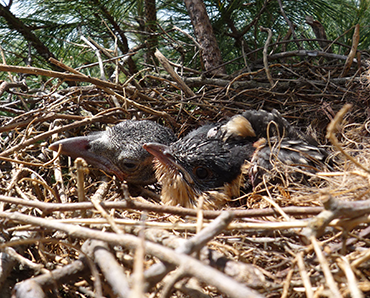
Canestrari studies a host species called the carrion crow. At first, she wasn’t focusing on brood parasitism. She just wanted to learn about crow behavior.
But some crow nests had been parasitized by great spotted cuckoos. When the cuckoo eggs hatched, the chicks didn’t push crow eggs out of the nest. They grew up alongside crow chicks.
“At a certain point, we noticed something that really puzzled us,” Canestrari says. Nests containing a cuckoo chick seemed more likely to succeed. By that she means that at least one crow chick survived long enough to fledge, or fly out on its own.
The researchers wondered if the reason had something to do with predators. Falcons and wild cats sometimes attack crow nests, killing all the chicks. Could the cuckoos be helping to defend nests from these attackers?
The researchers knew that when they picked up cuckoos, the birds squirted out a stinky liquid. They “always, always produce this terrible substance, which is absolutely disgusting,” Canestrari says. She wondered if cuckoos were sliming predators with the liquid.
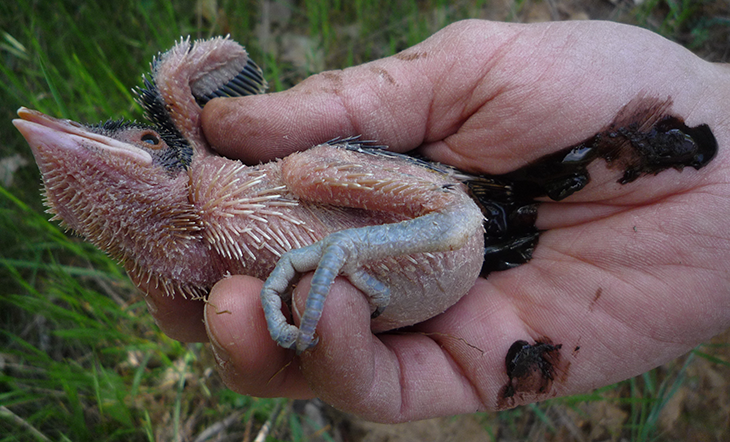
So the scientists found crow nests containing a cuckoo chick. They moved some cuckoos to crow nests that weren’t parasitized. Then the researchers monitored whether the nests succeeded. They also watched nests that had never contained a cuckoo chick.
About 70 percent of crow nests with added cuckoo chicks succeeded. This rate was similar to that of chicks in parasitized nests that kept their cuckoos.
But among nests whose cuckoo chicks were removed, only about 30 percent succeeded. And this rate was similar to what is seen in nests that never held a cuckoo.
“The presence of the cuckoo was causing this difference,” Canestrari concludes.
Then the researchers tested whether predators disliked the cuckoo’s stinky spray. They collected the liquid in a tube. Later, they smeared this stuff on raw chicken meat. Then they offered the doctored meat to cats and falcons.
The predators turned up their noses. Most of the cats “didn’t even touch the meat,” Canestrari says. The birds tended to pick it up, then reject it.
So cuckoo chicks do seem to protect crow nests. “The host is gaining some kind of benefit,” she says. “In some circumstances, a cuckoo chick is not a bad thing.”
Scientists find brood parasites fascinating because they’re rare. Most birds care for their own young instead of shoving the work onto someone else. Notes Hauber, brood parasites “are the exception to the rule.”
Note: This article was updated on October 15, 2019, to fix the definition of a brood parasite and clarify the experiment described in the final section.







